Drivers of Pinus halepensis Plant Community Structure across a Post-Fire Chronosequence
Abstract
:1. Introduction
2. Materials and Methods
2.1. Study Sites
2.2. Field Sampling
2.3. Data Analysis
3. Results
3.1. Effects of Post-Fire Stage on Aleppo Pine Forests’ Plant Community Diversity
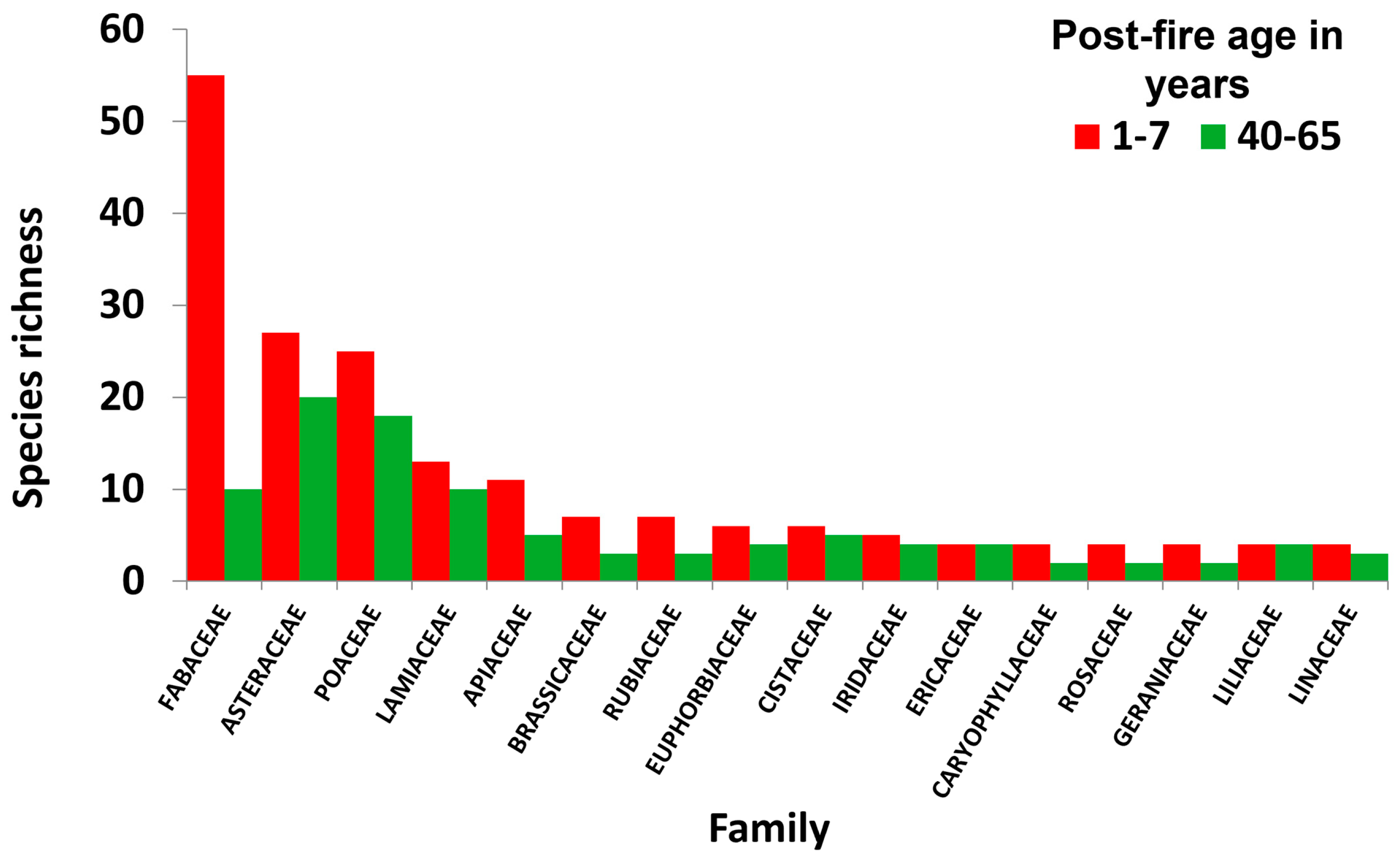
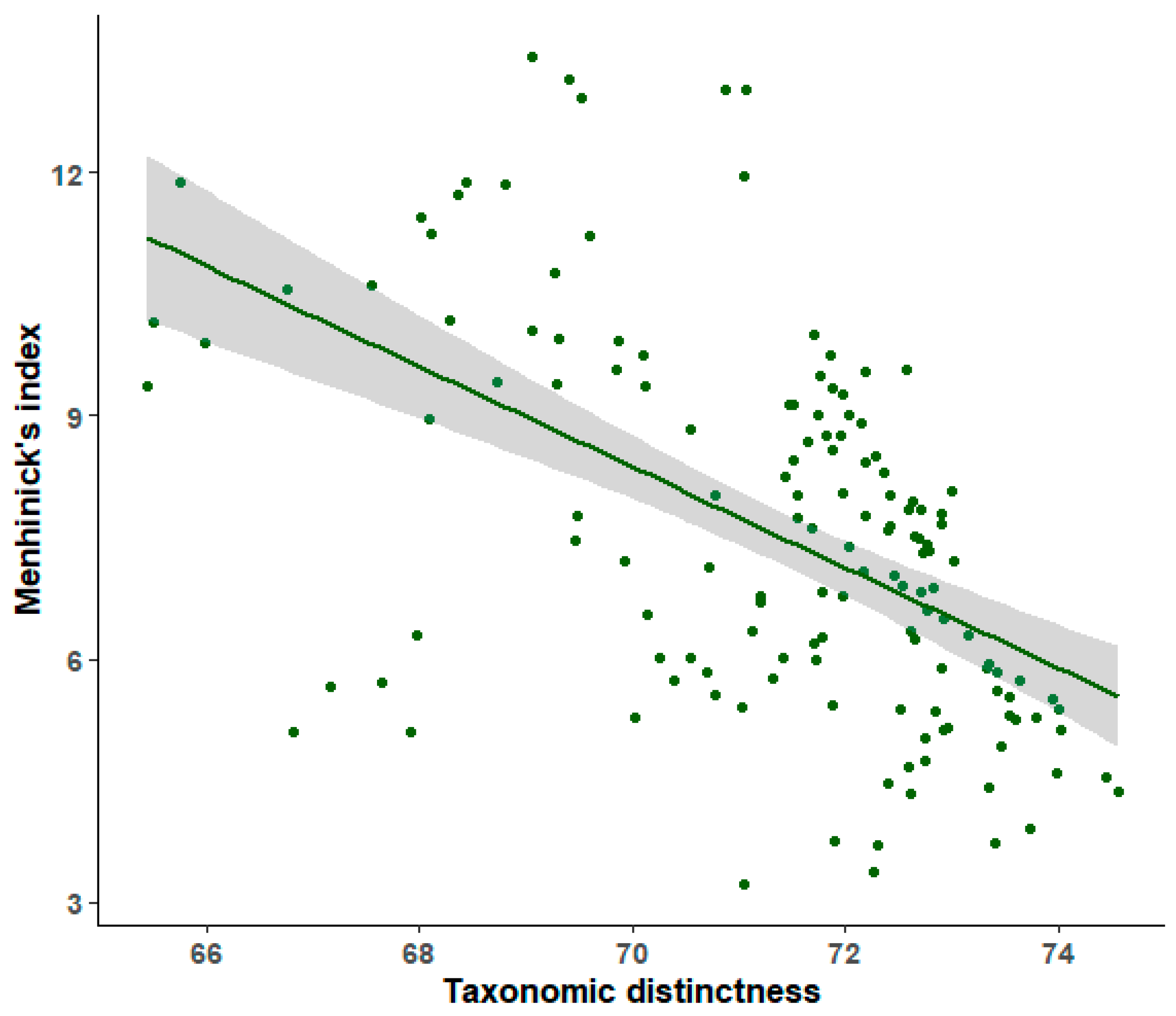
3.2. Effects of Post-Fire Stage on Aleppo Pine Forests’ Plant Community Composition
4. Discussion
5. Conclusions
Supplementary Materials
Author Contributions
Funding
Institutional Review Board Statement
Informed Consent Statement
Data Availability Statement
Acknowledgments
Conflicts of Interest
References
- Moreira, F.; Ascoli, D.; Safford, H.; Adams, M.; Moreno, J.M.; Pereira, J.C.; Catry, F.; Armesto, J.; Bond, W.J.; Gonzalez, M.; et al. Wildfire management in Mediterranean-type regions: Paradigm change needed. Environ. Res. Lett. 2020, 15, 011001. [Google Scholar] [CrossRef]
- Rundel, P.W.; Arroyo, M.T.K.; Cowling, R.M.; Keeley, J.E.; Lamont, B.B.; Vargas, P. Mediterranean biomes: Evolution of their vegetation, floras, and climate. Ann. Rev. Ecol. Evol. Syst. 2016, 47, 383–407. [Google Scholar] [CrossRef]
- San-Miguel-Ayanz, J.; Moreno, J.M.; Camia, A. Analysis of large fires in European Mediterranean landscapes: Lessons learned and perspectives. For. Ecol. Manag. 2013, 294, 11–22. [Google Scholar] [CrossRef]
- Moriondo, M.; Good, P.; Durao, R.; Bindi, M.; Giannakopoulos, C.; Corte-Real, J. Potential impact of climate change on fire risk in the Mediterranean area. Clim. Res. 2006, 31, 85–95. [Google Scholar] [CrossRef]
- Lindner, M.; Maroschek, M.; Netherer, S.; Kremer, A.; Barbati, A.; Garcia-Gonzalo, J.; Seidl, R.; Delzon, S.; Corona, P.; Kolström, M.; et al. Climate change impacts, adaptive capacity, and vulnerability of European forest ecosystems. For. Ecol. Manag. 2010, 259, 698–709. [Google Scholar] [CrossRef]
- Moreira, F.; Viedma, O.; Arianoutsou, M.; Curt, T.; Koutsias, N.; Rigolot, E.; Barbati, A.; Corona, P.; Vaz, P.; Xanthopoulos, G.; et al. Landscape–wildfire interactions in southern Europe: Implications for landscape management. J. Environ. Manag. 2011, 92, 2389–2402. [Google Scholar] [CrossRef]
- Moreno, J.M.; Morales-Molino, C.; Torres, I.; Arianoutsou, M. Fire in Mediterranean Pine Forests: Past, Present and Future. In Pines and Their Mixed Forest Ecosystems in the Mediterranean Basin; Ne’eman, G., Osem, Y., Eds.; Managing Forest Ecosystems; Springer: Cham, Switzerland, 2021; Volume 38, pp. 421–456. [Google Scholar] [CrossRef]
- Mauri, A.; Di Leo, M.; de Rigo, D.; Caudullo, G. Pinus halepensis and Pinus brutia in Europe: Distribution, habitat, usage and threats. In European Atlas of Forest Tree Species; San-Miguel-Ayanz, J., de Rigo, D., Caudullo, G., Houston Durrant, T., Mauri, A., Eds.; Publ. Off. EU: Luxembourg, 2016; pp. 122–123. [Google Scholar]
- Quézel, P. Taxonomy and biogeography of Mediterranean pines. In Ecology, Biogeography and Management of Pinus halepensis and P. brutia Forest Ecosystems in the Mediterranean Basin; Ne’eman, G., Trabaud, L., Eds.; Backhuys Publishers: Leiden, The Netherlands, 2000; pp. 1–12. [Google Scholar]
- Dafis, S. Ecology of Pinus halepensis and Pinus brutia forests. In Proceedings of the 1st Scientific Meeting of Hellenic Forestry Society on Pinus halepensis and Pinus brutia Forests, Chalkida, Thessaloniki, Greece, 30 September–2 October 1987; pp. 17–25. [Google Scholar]
- Barbero, M.; Loisel, R.; Quezel, P.; Richardson, D.M.; Romane, F. Pines of the Mediterranean Basin. 1998. In Ecology and Biogeography of Pinus; Richardson, D.M., Ed.; Cambridge University Press: Cambridge, UK, 1998; pp. 153–170. [Google Scholar]
- Kazanis, D. Post-Fire Succession of Pinus halepensis Mill. Forests: Patterns of Vegetations Dynamics. Ph.D. Thesis, National and Kapodistrian University of Athens, Athens, Greece, 2005; 350p. (In Greek). [Google Scholar]
- Daskalakou, E.; Albanis, K.; Skouteri, A.; Thanos, C.A. Predicting time-windows for full recovery of postfire regenerating Pinus halepensis Mill. forests after a future wildfire. New For. 2014, 45, 53–70. [Google Scholar] [CrossRef]
- Trabaud, L. Post-fire regeneration in Pinus halepensis forests in the West Mediterranean. In Ecology Biogeography and Management of Pinus halepensis and Pinus brutia Forest Ecosystems in the Mediterranean Basin; Ne’eman, G., Trabaud, L., Eds.; Backhuys Publishers: Leiden, The Netherlands, 2000; pp. 257–268. [Google Scholar]
- Kazanis, D.; Arianoutsou, M. Long-term post-fire vegetation dynamics in Pinus halepensis forests of Central Greece: A functional group approach. Plant Ecol. 2004, 171, 101–121. [Google Scholar] [CrossRef]
- Ne’eman, G.; Arianoutsou, M. Mediterranean Pines—Adaptations to Fire. In Pines and Their Mixed Forest Ecosystems in the Mediterranean Basin; Ne’eman, G., Osem, Y., Eds.; Managing Forest Ecosystems; Springer: Cham, Switzerland, 2021; Volume 38, pp. 457–480. [Google Scholar] [CrossRef]
- Nakas, G.; Kougioumoutzis, K.; Petanidou, T. Short- and Mid-Term Spatiotemporal Diversity Patterns of Post-Fire Insect-Pollinated Plant Communities in the Mediterranean. Land 2023, 12, 2109. [Google Scholar] [CrossRef]
- Thanos, C.A.; Daskalakou, E.N.; Nikolaidou, S. Early post-fire regeneration of a Pinus halepensis forest on Mount Parnis, Greece. J. Veg. Sci. 1996, 7, 273–280. [Google Scholar] [CrossRef]
- Daskalakou, E.N.; Thanos, C.A. Postfire seedling dynamics and performance in Pinus halepensis Mill. populations. Acta Oecologica 2010, 36, 446–453. [Google Scholar] [CrossRef]
- Ne’eman, G. Regeneration of natural pine forest–review of work done after the 1989 fire in Mount Carmel, Israel. Int. J. Wildland Fire 1997, 7, 295–306. [Google Scholar] [CrossRef]
- Verroios, G.; Georgiadis, T. Post-fire vegetation succession: The case of Aleppo pine (Pinus halepensis Miller) forests of Northern Achaia (Greece). Fresenius Environ. Bull. 2002, 11, 186–193. [Google Scholar]
- González-De Vega, S.; De Las Heras, J.; Moya, D. Resilience of Mediterranean terrestrial ecosystems and fire severity in semiarid areas: Responses of Aleppo pine forests in the short, mid and long term. Forests 2018, 9, 299. [Google Scholar] [CrossRef]
- Ministry of Agriculture. First National Inventory of Greece; General Secretariat of Forests and Natural Environment: Athens, Greece, 1992; 134p. (In Greek) [Google Scholar]
- Arianoutsou, M. Landscape changes in Mediterranean ecosystems of Greece: Implications for fire and biodiversity issues. J. Medit. Ecol. 2001, 2, 165–178. [Google Scholar]
- Mallinis, G.; Koutsias, N.; Arianoutsou, M. Monitoring land use/land cover transformations from 1945 to 2007 in two peri-urban mountainous areas of Athens metropolitan area, Greece. Sci. Total Environ. 2014, 490, 262–278. [Google Scholar] [CrossRef]
- Brower, J.E.; Zar, J.H.; Van Ende, C.M. Field and Laboratory Methods for General Ecology, 3rd ed.; William, C., Ed.; Brown Company: Dubuque, Iowa, 1990. [Google Scholar]
- Kazanis, D.; Arianoutsou, M. Factors determining low Mediterranean ecosystems resilience to fire: The case of Pinus halepensis forests. In Ecology, Conservation and Management of Mediterranean Climate Ecosystems; Arianoutsou, M., Papanastasis, V.P., Eds.; Millpress, Electronic Edition: Rotterdam, The Netherlands, 2004; 13p. [Google Scholar]
- Menhinick, E.F. A Comparison of Some Species-Individuals Diversity Indices Applied to Samples of Field Insects. Ecology 1964, 45, 859–861. [Google Scholar] [CrossRef]
- Pielou, E.C. Ecological Diversity; Wiley InterScience: New York, NY, USA, 1975. [Google Scholar]
- Berger, W.H.; Parker, F.L. Diversity of planktonic Foraminifera in deep sediments. Science 1970, 168, 1345–1347. [Google Scholar] [CrossRef]
- Warwick, R.M.; Clarke, K.R. New ‘biodiversity’ measures reveal a decrease in taxonomic distinctness with increasing stress. Mar. Ecol. Prog. Ser. 1995, 129, 301–305. [Google Scholar] [CrossRef]
- Lüdecke, D.; Ben-Shachar, M.; Patil, I.; Waggoner, P.D.; Makowski, D. Performance: An R Package for Assessment, Comparison and Testing of Statistical Models. J. Open Source Softw. 2021, 6, 3139. [Google Scholar] [CrossRef]
- Bray, J.R.; Curtis, J.T. An Ordination of the Upland Forest Communities of Southern Wisconsin. Ecol. Monogr. 1957, 27, 325–349. [Google Scholar] [CrossRef]
- Mokany, K.; Ware, C.; Woolley, S.N.C.; Ferrier, S.; Fitzpatrick, M.C. A working guide to harnessing generalized dissimilarity modelling for biodiversity analysis and conservation assessment. Glob. Ecol. Biogeogr. 2022, 31, 802–821. [Google Scholar] [CrossRef]
- R Core Team. R: A Language and Environment for Statistical Computing; R Foundation for Statistical Computing: Vienna, Austria, 2024; Available online: https://www.R-project.org/ (accessed on 1 June 2024).
- Hartig, F.; DHARMa: Residual Diagnostics for Hierarchical (Multi-Level/Mixed) Regression Models. R Package Version 0.4.6. 2022. Available online: https://CRAN.R-project.org/package=DHARMa (accessed on 1 June 2024).
- Oksanen, J.; Simpson, G.; Blanchet, F.; Kindt, R.; Legendre, P.; Minchin, P.; O’Hara, R.; Solymos, P.; Stevens, M.; Szoecs, E.; et al. Vegan: Community Ecology Package. R Package Version 2.6-4. 2022. Available online: https://CRAN.R-project.org/package=vegan (accessed on 1 June 2024).
- Fitzpatrick, M.C.; Mokany, K.; Manion, G.; Ferrier, S. gdm: Generalized Dissimilarity Modeling. R Package Version 1.5.0.. 2021. Available online: https://mfitzpatrick.al.umces.edu/gdm/ (accessed on 1 June 2024).
- Bates, D.; Maechler, M.; Bolker, B.; Walker, S. Fitting Linear Mixed-Effects Models Using lme4. J. Stat. Softw. 2015, 67, 48. [Google Scholar] [CrossRef]
- Wickham, H. Ggplot2: Elegant Graphics for Data Analysis; Springer: New York, NY, USA, 2016. [Google Scholar]
- Brooks, M.E.; Kristensen, K.; van Benthem, K.J.; Magnusson, A.; Berg, C.W.; Nielsen, A.; Skaug, H.J.; Maechler, M.; Bolker, B.M. glmmTMB Balances Speed and Flexibility Among Packages for Zero-inflated Generalized Linear MixedModeling. R J. 2017, 9, 378–400. [Google Scholar] [CrossRef]
- Tavşanoğlu, Ç.; Gürkan, B. Post-fire regeneration of a Pinus brutia (Pinaceae) forest in Marmaris National Park, Turkey. Int. J. Bot. 2009, 5, 107–111. [Google Scholar] [CrossRef]
- Kaye, J.P.; Romanyà, J.; Vallejo, R.V. Plant and soil carbon accumulation following fire in Mediterranean woodlands in Spain. Oecologia 2010, 164, 533–543. [Google Scholar] [CrossRef]
- Fournier, T.; Fèvre, J.; Carcaillet, F.; Carcaillet, C. For a few years more: Reductions in plant diversity 70 years after the last fire in Mediterranean forests. Plant Ecol. 2020, 221, 559–576. [Google Scholar] [CrossRef]
- Egler, F.E. Vegetation science concepts. I. Initial floristic composition—A factor in old-field vegetation development. Vegetatio 1954, 4, 412–418. [Google Scholar] [CrossRef]
- Clements, F.E. Plant Succession. An Analysis of the Development of Vegetation; Publication 242; Carnegie Institute: Washington, DC, USA, 1916. [Google Scholar]
- Connell, J.H. Diversity in tropical rainforests and coral reefs: High diversity of trees and corals is maintained only in a nonequilibrium state. Science 1978, 199, 1302–1310. [Google Scholar] [CrossRef]
- Purdie, R.W.; Slatyer, R.O. Vegetation succession after fire in sclerophyll woodland communities in south-eastern Australia. Aust. J. Ecol. 1976, 1, 223–236. [Google Scholar] [CrossRef]
- Trabaud, L.; Lepart, J. Diversity and stability in garrigue ecosystems after fire. Vegetatio 1980, 43, 49–57. [Google Scholar] [CrossRef]
- Guo, Q. Early post-fire succession in California chaparral: Changes in diversity, density, cover and biomass. Ecol. Res. 2001, 16, 471–485. [Google Scholar] [CrossRef]
- Capitanio, R.; Carcaillet, C. Post-fire Mediterranean vegetation dynamics and diversity: A discussion of succession models. For. Ecol. Manag. 2008, 255, 431–439. [Google Scholar] [CrossRef]
- Kavgacı, A.; Čarni, A.; Başaran, S.; Başaran, M.A.; Košir, P.; Marinšek, A.; Šilc, U. Long-term post-fire succession of Pinus brutia forest in the east Mediterranean. Int. J. Wildland Fire 2010, 19, 599–605. [Google Scholar] [CrossRef]
- Spatharis, S.; Roelke, D.L.; Dimitrakopoulos, P.G.; Kokkoris, G.D. Analyzing the (mis)behavior of Shannon index in eutrophication studies using field and simulated phytoplankton assemblages. Ecol. Indic. 2011, 11, 697–703. [Google Scholar] [CrossRef]
- Winkler, M.; Lamprecht, A.; Steinbauer, K.; Hülber, K.; Theurillat, J.; Breiner, F.; Choler, P.; Ertl, S.; Girón, A.G.; Rossi, G.; et al. The rich sides of mountain summits—A pan-European view on aspect preferences of alpine plants. J. Biogeogr. 2016, 43, 2261–2273. [Google Scholar] [CrossRef]
- Schuler, A. Contribution to the flora of northern and central Greece. Willdenowia 2007, 37, 229–241. [Google Scholar] [CrossRef]
- Panitsa, M.; Kokkoris, I.P.; Kougioumoutzis, K.; Kontopanou, A.; Bazos, I.; Strid, A.; Dimopoulos, P. Linking Taxonomic, Phylogenetic and Functional Plant Diversity with Ecosystem Services of Cliffs and Screes in Greece. Plants 2021, 10, 992. [Google Scholar] [CrossRef]
- Vilaplana, D.F.; Lucas-Borja, M.E.; Soria, R.; Miralles, I.; Ortega, R.; Abdennbi, S.; Carmona-Yanez, M.D.; Plaza-Alvarez, P.A.; Santana, V.M.; Zema, D.A. One-year effects of stand age, pre-fire treatments, and hillslope aspect on recovery of plant diversity and soil properties in a Mediterranean forest burnt by a severe wildfire. For. Ecol. Manag. 2024, 566, 122068. [Google Scholar] [CrossRef]
- Harvey, B.J.; Holzman, B.A. Divergent successional pathways of stand development following fire in a California closed-cone pine forest. J. Veg. Sci. 2014, 25, 88–99. [Google Scholar] [CrossRef]
- Cowling, R.M.; Rundel, P.W.; Lamont, B.B.; Arroyo, M.K.; Arianoutsou, M. Plant diversity in Mediterranean-climate regions. Trends Ecol. Evol. 1996, 11, 362–366. [Google Scholar] [CrossRef] [PubMed]
- Bond, W.J.; Van Wilgen, B.W. Fire and Plants; Chapman & Hall: London, UK, 1996. [Google Scholar]
- Gill, A.M. Biodiversity and bushfires: An Australia-wide perspective on plant-species changes after a fire event. In Australia’s Biodiversity—Responses to Fire. Plants, Birds and Invertebrates; Gill, A.M., Woinarski, J.C.Z., York, A., Eds.; Biodiversity Technical Paper No. 1; Department of the Environment and Heritage: Canberra, ACT, Australia, 1999; pp. 9–53. [Google Scholar]
- Keeley, J.E.; Bond, W.J.; Bradstock, R.A.; Pausas, J.G.; Rundel, P.W. Fire in Mediterranean Ecosystems: Ecology, Evolution and Management; Cambridge University Press: Cambridge, UK, 2012. [Google Scholar]
- Ferrier, S.; Manion, G.; Elith, J.; Richardson, K. Using generalized dissimilarity modelling to analyse and predict patterns of beta diversity in regional biodiversity assessment. Divers. distrib. 2007, 13, 252–264. [Google Scholar] [CrossRef]
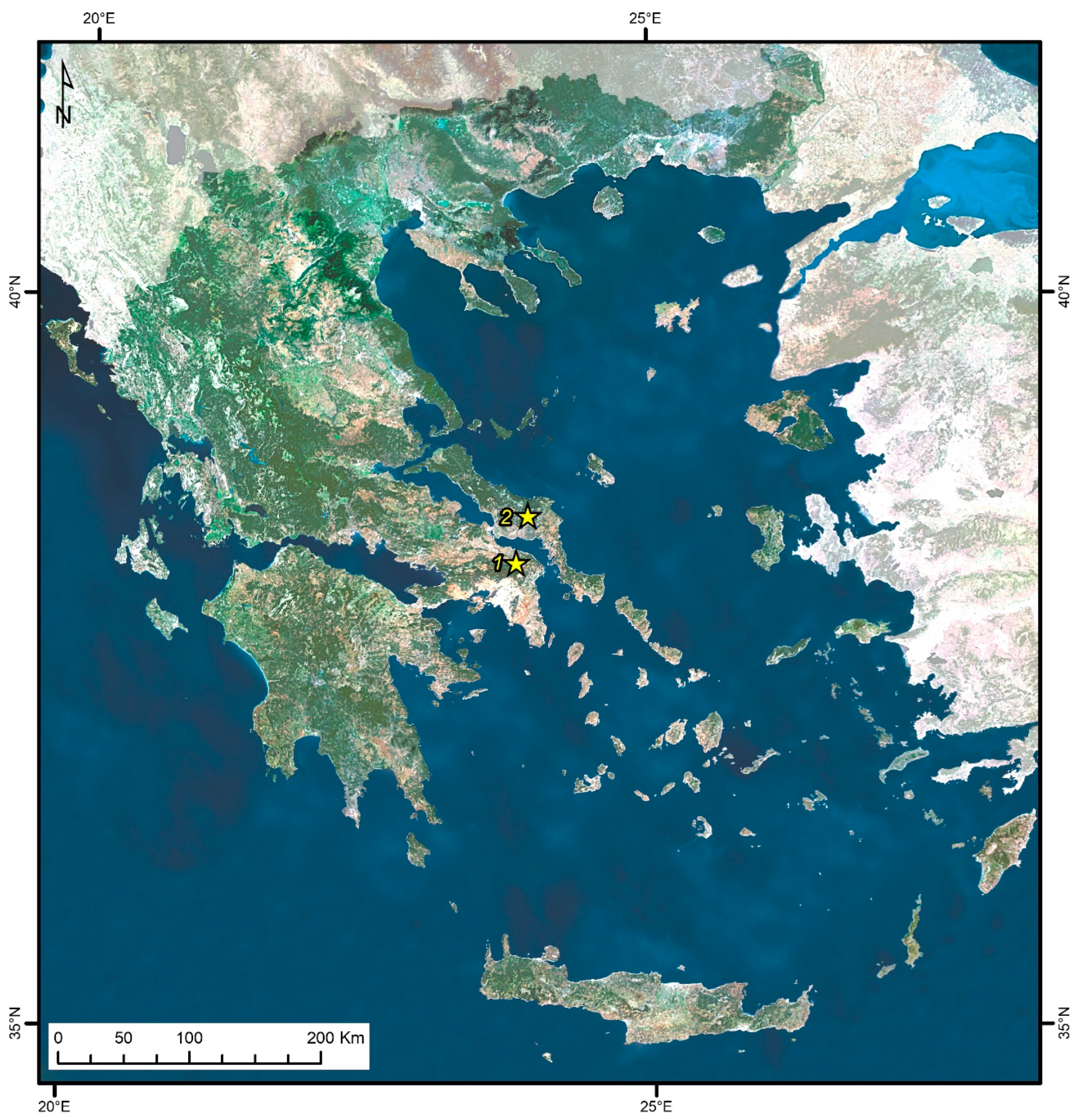
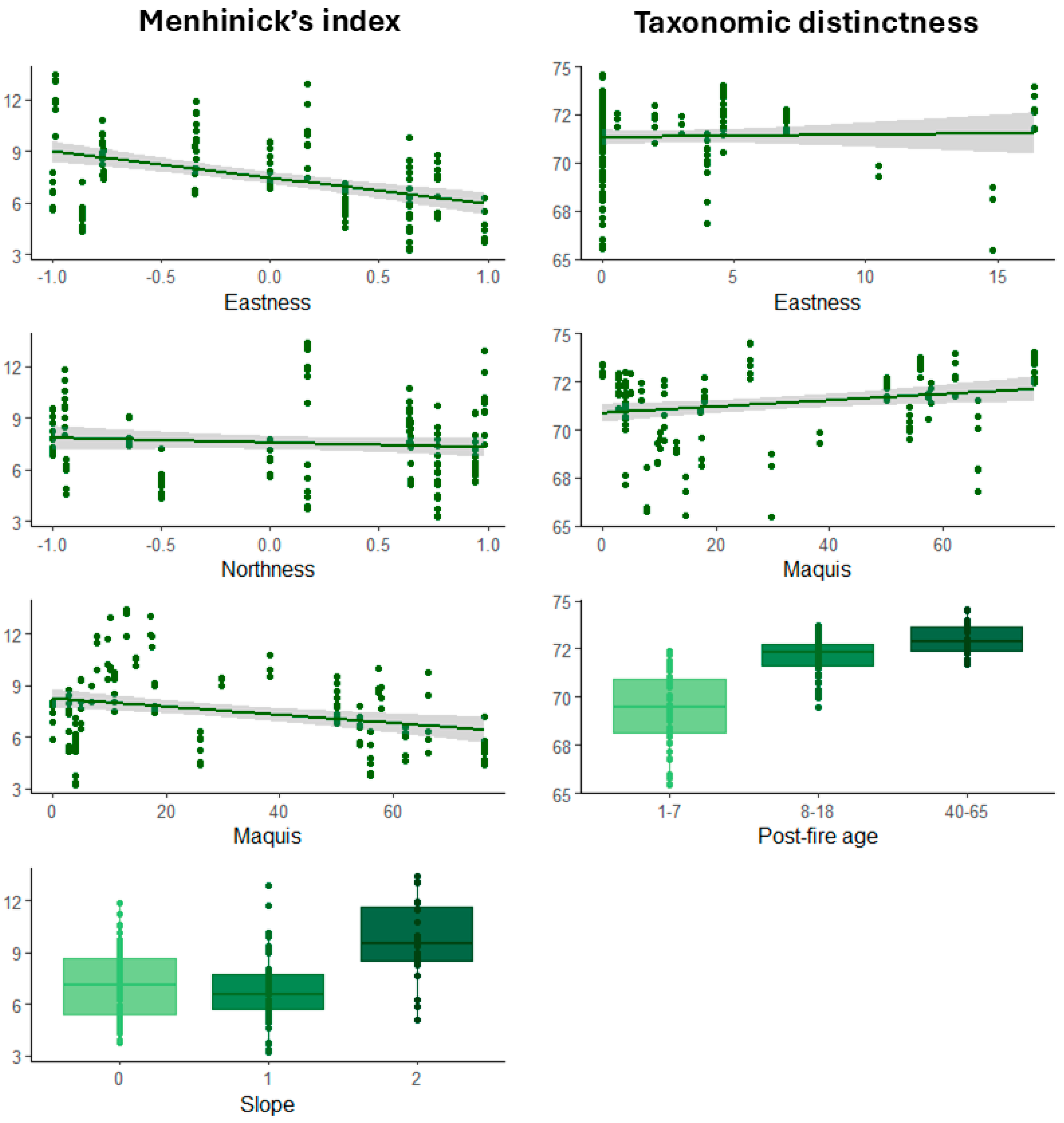
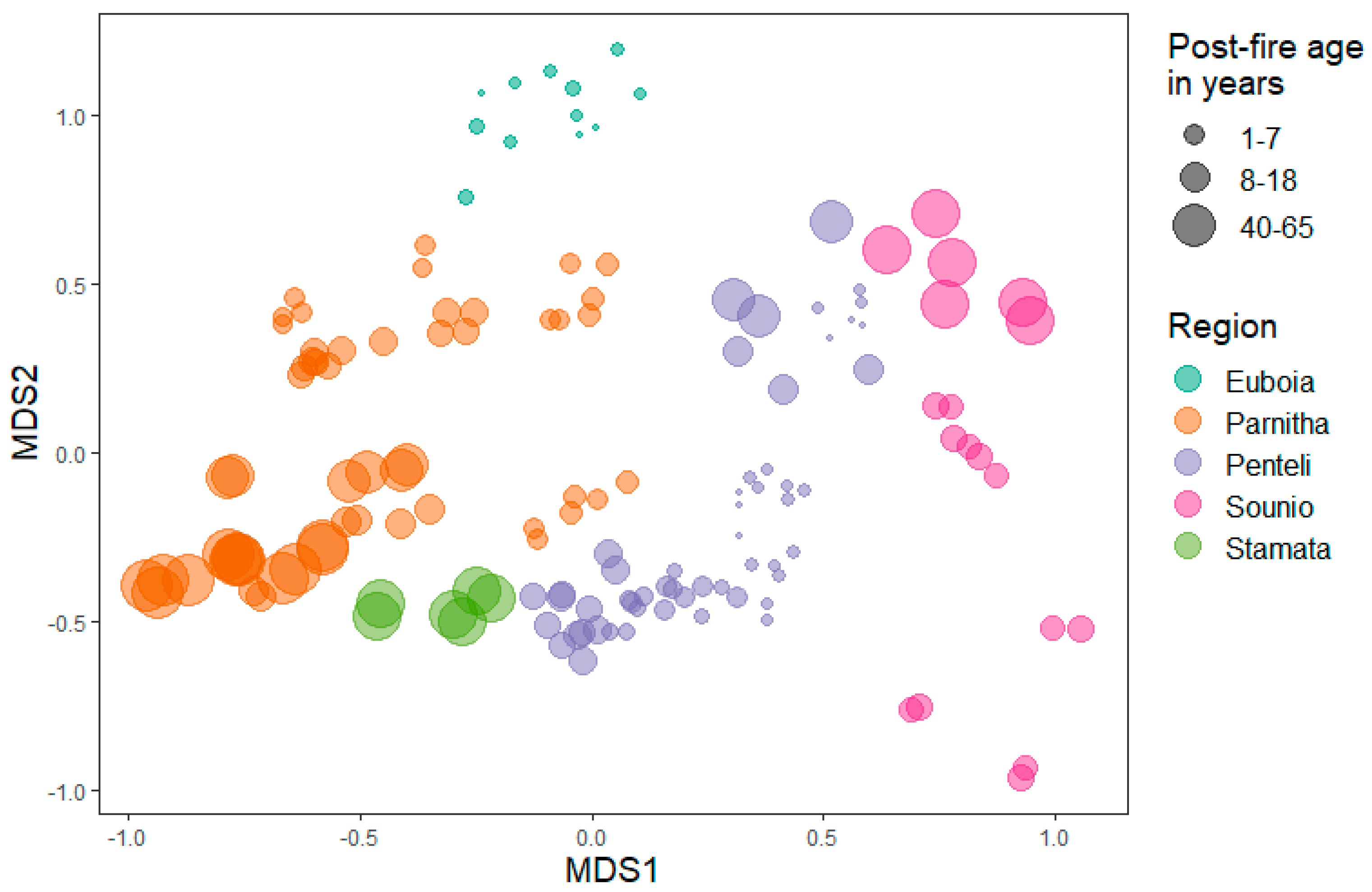
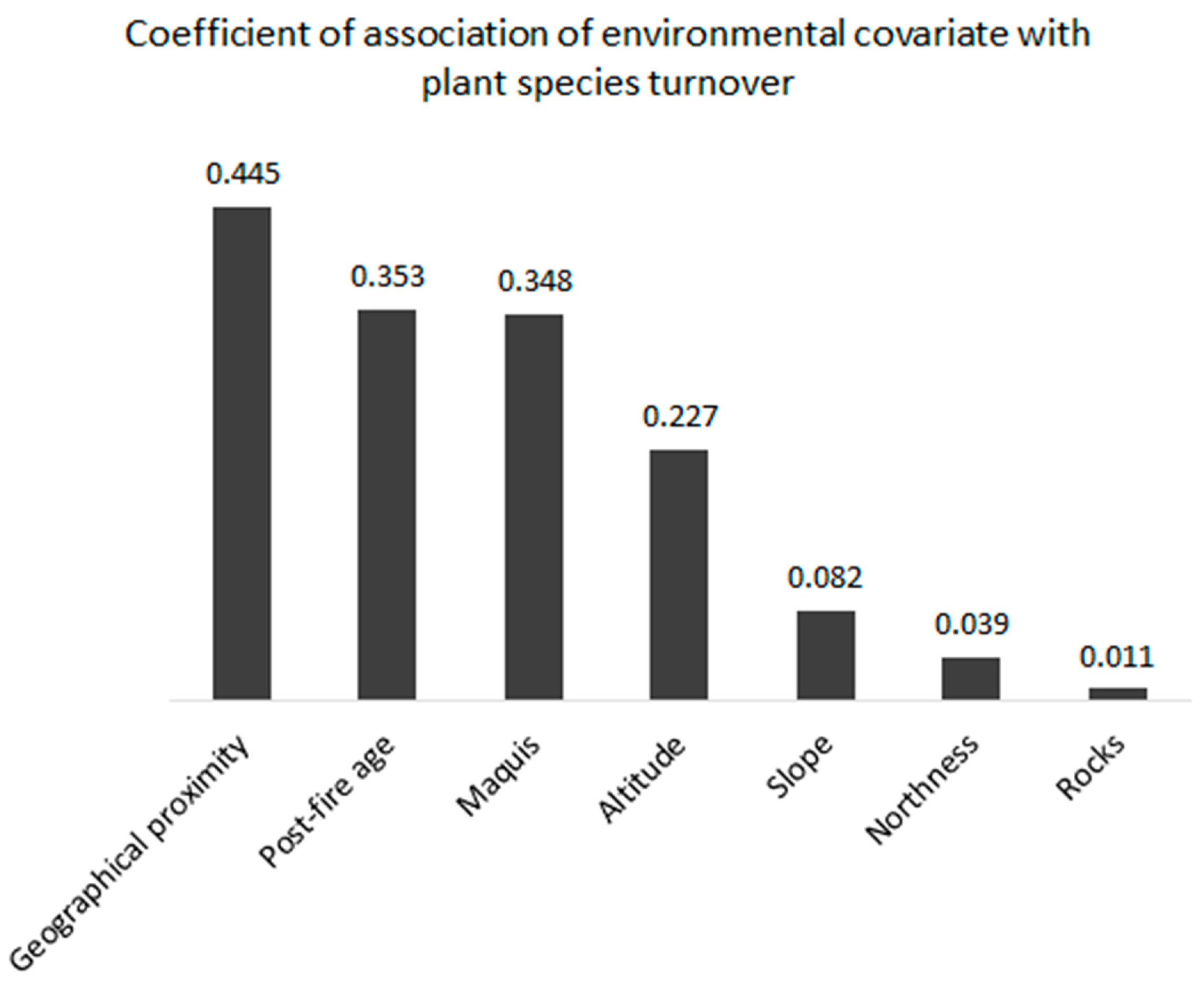
| Site Name | Site Code | Region | Fire Year | Post-Fire Age (Years Since Fire) | Altitude (m a.s.l) | Parent-Rock Material | Slope Inclination | Slope Aspect (Degrees) |
|---|---|---|---|---|---|---|---|---|
| Mavrinora | Mav | Mt Penteli | 1995 | 1–3 | 420 | Schist | 2 | 280 |
| Pikermi | Pik | Mt Penteli | 1995 | 1–2 | 180 | Tertiary deposits | 0 | 200 |
| Loutsa | Lou | Evoia, Mt Dirfy | 1994 | 1–4 | 350 | Limestone | 2 | 310 |
| Agios Stefanos | Ags | Mt Penteli | 1993 | 2–5 | 310 | Schist | 1 | 10 |
| Stamata | Sta | Mt Penteli | 1990 | 5–8 | 405 | Schist | 1 | 20 |
| Avlona | Avl | Mt Parnitha | 1991 | 6–7 | 360 | Limestone | 2 | 40 |
| Fili | Fyl | Mt Parnitha | 1989 | 8–9 | 410 | Limestone | 1 | 270 |
| Fili | Fys | Mt Parnitha | 1989 | 8–9 | 410 | Schist | 1 | 230 |
| Kamariza | Kam | Sounion National Park | 1985 | 12–13 | 170 | Limestone | 1 | 40 |
| Kamariza | Kas | Sounion National Park | 1985 | 12–13 | 170 | Schist | 1 | 40 |
| Beletsi | Bel | Mt Parnitha | 1982 | 13–16 | 590 | Limestone | 0 | 180 |
| Dionisos | Dio | Mt Penteli | 1982 | 13–16 | 460 | Schist | 0 | 50 |
| Bahounia | Bah | Mt Parnitha | 1980 | 17–18 | 660 | Limestone | 0 | 80 |
| Pikermi | PikY | Mt Penteli | 1977 | 17 | 180 | Tertiary deposits | 0 | 200 |
| Pikermi | PikM | Mt Penteli | No fire | 40 | 180 | Tertiary deposits | 0 | 200 |
| Tatoi | Tat | Mt Parnitha | No fire | 40 | 560 | Limestone | 1 | 160 |
| Pontos | Pon | Mt Penteli | No fire | 55 | 420 | Schist | 0 | 40 |
| Markati | Sou | Sounion National Park | No fire | 55 | 180 | Schist | 0 | 340 |
| Agios Merkourios | Agm | Mt Parnitha | No fire | 65 | 580 | Schist | 0 | 240 |
| Explanatory Variables | Response Variables | ||||
|---|---|---|---|---|---|
| Species Richness | Menhinick’s Index | Taxonomic Distinctness | Pielou Evenness | Dominance Berger–Parker | |
| Rock cover | 0.25, 1 p = 0.62 | 0.35, 1 p = 0.55 | 12.41, 1 p < 0.001 *** | 2.35, 1 p > 0.05 | 2.04, 1 p > 0.05 |
| Northness | 1.55, 1 p = 0.21 | 3.93, 1 p = 0.04 * | 0.11, 1 p = 0.74 | 0.91, 31 p > 0.05 | 0.00, 1 p > 0.05 |
| Eastness | 4.08, 1 p = 0.043 * | 5.04, 1 p = 0.02 * | 2.85, 1 p = 0.91 | 0.35, 1 p > 0.05 | 1.27, 1 p > 0.05 |
| Altitude | 0.16, 1 p = 0.69 | 0.01, 1 p = 0.91 | 0.04, 1 p = 0.84 | 0.46, 1 p > 0.05 | 0.86, 1 p > 0.05 |
| Maquis cover | 3.45, 1 p = 0.06 | 8.07, 1 p < 0.01 ** | 8.72, 1 p < 0.01 ** | 0.00, 1 p > 0.05 | 0.77, 1 p > 0.05 |
| Slope | 4.71, 2 p = 0.09 | 8.25, 2 p = 0.05 * | 1.35, 2 p = 0.51 | 3.9, 2 p > 0.05 | 1.86, 2 p > 0.05 |
| Post-fire period | 1.62, 2 p = 0.44 | 1.66, 2 p = 0.43 | 8.37, 2 p = 0.01 * | 1.03, 2 p > 0.05 | 0.28, 2 p > 0.05 |
Disclaimer/Publisher’s Note: The statements, opinions and data contained in all publications are solely those of the individual author(s) and contributor(s) and not of MDPI and/or the editor(s). MDPI and/or the editor(s) disclaim responsibility for any injury to people or property resulting from any ideas, methods, instructions or products referred to in the content. |
© 2024 by the authors. Licensee MDPI, Basel, Switzerland. This article is an open access article distributed under the terms and conditions of the Creative Commons Attribution (CC BY) license (https://creativecommons.org/licenses/by/4.0/).
Share and Cite
Kazanis, D.; Spatharis, S.; Kokkoris, G.D.; Dimitrakopoulos, P.G.; Arianoutsou, M. Drivers of Pinus halepensis Plant Community Structure across a Post-Fire Chronosequence. Fire 2024, 7, 331. https://doi.org/10.3390/fire7090331
Kazanis D, Spatharis S, Kokkoris GD, Dimitrakopoulos PG, Arianoutsou M. Drivers of Pinus halepensis Plant Community Structure across a Post-Fire Chronosequence. Fire. 2024; 7(9):331. https://doi.org/10.3390/fire7090331
Chicago/Turabian StyleKazanis, Dimitris, Sofie Spatharis, Giorgos D. Kokkoris, Panayiotis G. Dimitrakopoulos, and Margarita Arianoutsou. 2024. "Drivers of Pinus halepensis Plant Community Structure across a Post-Fire Chronosequence" Fire 7, no. 9: 331. https://doi.org/10.3390/fire7090331







